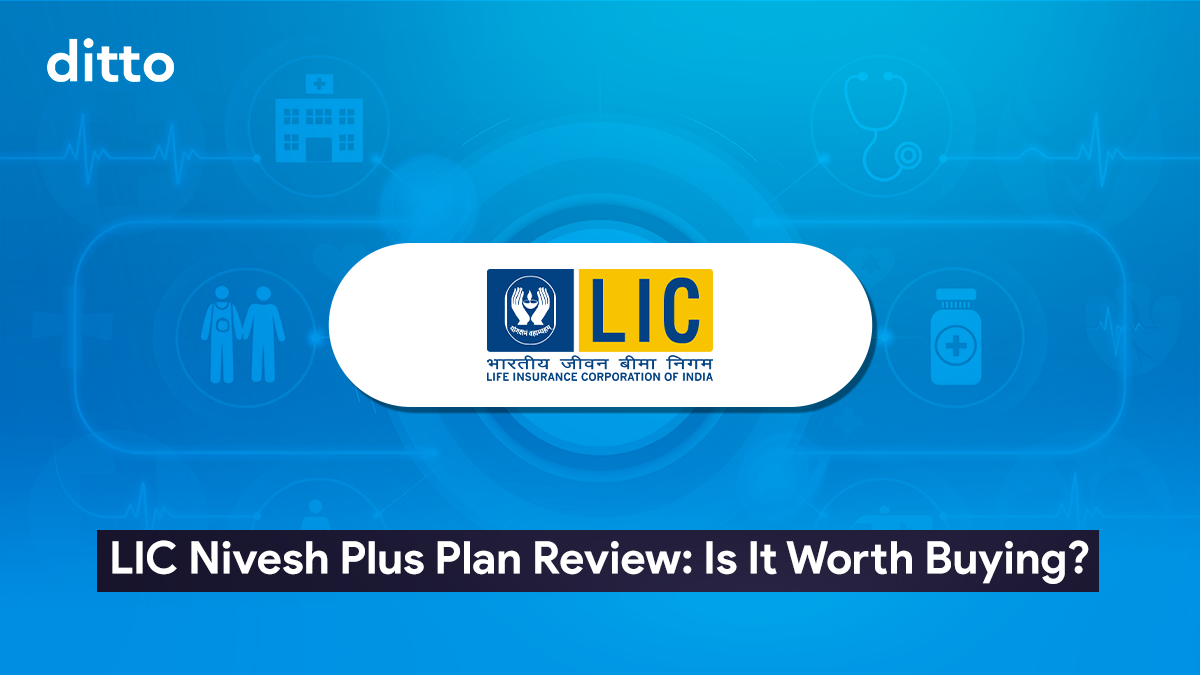LIC’s “Nivesh Plus” promises the magic formula: invest once, get market returns, and enjoy life cover. Sounds like a win-win? Not so fast. Behind the glossy pitch is a ULIP with layered charges, a 5-year lock-in, and fine print you can’t ignore. In fact, from mid-2024, IRDAI even stopped insurers from selling ULIPs as pure investment products after too many people mistook them for mutual funds.
So before you park your hard-earned lump sum here, let’s break down what Nivesh Plus really offers and whether it deserves a place in your portfolio.
Confused about ULIPs vs Mutual Funds? Let Ditto help you choose the right insurance. Talk to an advisor for free today.
Book a Free Call With Ditto
What is the LIC Nivesh Plus Plan?
LIC Nivesh Plus is a ULIP that combines life insurance coverage with market-linked investments. You pay a lump-sum premium once, choose a fund option, and get insurance protection along with investment growth based on market performance.
How the Plan Actually Works
1) Single Premium Allocation
After you make your one-time premium payment, LIC deducts a premium allocation charge (3.3% for offline and 1.5% for online purchases). The balance is then invested in one of the four funds available: Bond, Secured, Balanced, or Growth, based on your risk preference.
2) Life Insurance Cover
You can choose between two sum assured options:
- 1.25x of premium (available up to age 70)
- 10x of premium (available only up to age 35)
3) Fund Growth + Charges
Your money grows based on the fund's net asset value (NAV). Still, there are ongoing charges, including the fund management charge (1.35% p.a.), mortality charges (which are age-based), and charges for switching, partial withdrawal, and discontinuance.
Now that we’ve covered how LIC Nivesh Plus works at a high level, let’s dive into the key features that define this plan.
Key Features of LIC Nivesh Plus Plan
When you invest in LIC Nivesh Plus, you get to choose between two types of sum assured (Option 1 and Option 2). The main difference here comes down to how much life cover you want compared to how much of your money gets invested. But before we explore the variants let’s look at the core features:
1) Premium Payment
You pay just once at the start; no future instalments or top-ups are allowed under the policy wording.
2) Premium Range
- Minimum: ₹1,25,000 (in multiples of ₹5,000)
- Maximum: No cap
3) Eligibility
- Entry age: 90 days to 70 years
- Maturity age: Up to 85 years
4) Sum Assured on Death
- 1.25 × single premium amount (Option 1)
- 10 x single premium amount (Option 2)
5) Policy Term
- 10 to 25 years (varies with entry age and sum assured option)
As per the policy wording, Shorter tenures are available only when the chosen term still ends before age-85.
6) Fund Options
- Bond Fund – Low risk
- Secured Fund – Low to Medium risk
- Balanced Fund – Medium risk
- Growth Fund – High risk
Each fund’s equity–debt mix is pre-defined in the policy; you can select one or switch later within limits.
7) Fund Switching
The policy wording caps free flexibility at 4 moves annually and levies a ₹100 charge for extra switches.
8) Guaranteed Additions (as % of premium)
These are added as extra units on the exact policy anniversaries once the corresponding milestone is reached.
- Year 6: 3%
- Year 10: 4%
- Year 15: 5%
- Year 20: 6%
- Year 25: 7%
9) Partial Withdrawals
These allow you to take out a portion of your invested money (fund value) before the policy ends (allowed after 5 years if fund value ≥ single premium).
- Years 6–10: 15% of fund value
- Years 11–15: 20%
- Years 16–20: 25%
- Years 21–25: 30%
10) Rider Option
- LIC’s Linked Accidental Death Benefit: If an accident (LIC defines this as a sudden, external, violent event) claims your life within 180 days of the mishap, this rider chips in an extra lump-sum.
Now that we’ve covered the core features, let’s look at the two variants LIC Nivesh Plus offers:
Option 1: Lower Cover, Higher Investment
This option puts more of your premium into investments, so growth potential is higher, but the life cover is tiny.
Example: Pay ₹1.25 lakh (one time). After 20 years → get ₹2.17L @4% or ₹4.41L @8%, with just ₹1.56L death cover. That’s far too low to serve any real life insurance purpose.
Option 2: Higher Cover, Lower Investment
Here, more of your premium goes to life cover, so investments take a back seat.
Example: Pay ₹1.25 lakh (one time). After 20 years → get ₹1.36L @4% or ₹3.35L @8%, with ₹12.5L death cover (10× premium). Better cover than Option 1, but still grossly inadequate to truly replace lost income.
| Did you know? Many private ULIPs offer high coverage, allowing entry up to 60 and policy terms lasting until 75 or even 85, so while Option 2 seems worth it on paper, there are better ULIPs you can consider for the same price point. |
With the plan features in place, it’s essential to understand the actual investment choices you have under LIC Nivesh Plus.
Investment Funds in LIC Nivesh Plus Plan
LIC Nivesh Plus gives you four fund options to choose from. Each one is like a different "basket" of investments, based on how much risk you're comfortable taking, from very safe to high risk.
Let’s break them down in simple terms:
1) Bond Fund: Low risk (primarily government securities)
The objective of this fund is to provide relatively safe and less volatile returns through investments primarily in fixed income securities.
Asset Allocation
- Government/ Government Guaranteed Securities/ Corporate Debt: ≥ 60%
- Short-term investments (money market instruments like treasury bills, commercial paper): ≤ 40%
- Equity: 0%
So, how does it work? Your money is not exposed to equity markets. Instead, it is primarily invested in government bonds and high-rated debt instruments. This means:
- Low risk of loss
- Predictable and steady returns
This is ideal for conservative investors who prioritize capital preservation over high growth.
2) Secured Fund: Moderate risk (mix of debt + equity)
The objective is to generate a steady income through a combination of debt and equity investments.
Asset Allocation
- Government/ Government Guaranteed Securities/ Corporate Debt: 45%-85%
- Equity: 15%-55%
- Money Market Instruments: ≤ 40%
Only about 15 to 55% of your funds are invested in the stock market, making it relatively safe while also providing some growth potential.
3) Balanced Fund: Medium risk (more equity exposure)
The objective is to provide balanced income and growth by investing in equal proportions of equity and debt instruments.
Asset Allocation
- Government/ Government Guaranteed Securities/ Corporate Debt: 30%-70%
- Equity: 30%-70%
- Money Market Instruments: ≤ 40%
This fund has a 50-50 split between equity and debt, resulting in a balanced profile. It has higher growth potential than the Secured Fund, but also higher short-term volatility.
4) Growth Fund: High risk, high return potential (predominantly equity)
The objective is to provide long-term capital growth through a higher allocation to equities
Asset Allocation
- Government/ Government Guaranteed Securities/ Corporate Debt: 20%-60%
- Equity: 40%-80%
- Money Market Instruments: ≤ 40%
In this fund, a large part of your money is invested in the stock market. The returns here can be the highest over time, but can also dip in the short term. This type is ideal for long-term investors who are comfortable with market fluctuations.
To provide a clearer picture, here’s a sample illustration that breaks down how your premium is allocated and what returns you can expect.
Sample Premium Illustration of LIC Nivesh Plus Plan
To calculate a sample premium, let’s take some key assumptions.
Let’s take a 26-year-old with a 20-year term, ₹2.5 lakh single premium (online), Growth Fund, and 10× cover (₹25 lakh sum assured), with no rider. As per IRDAI guidelines, returns are assumed at 4% and 8%, and GST of 18% applies on all charges.
From the ₹2.5 lakh premium,
- ₹3,750 (1.5%) is deducted upfront, leaving ₹2,46,250 to be invested.
- Mortality charges start at ~₹2,800 per year and rise to ~₹7,600 by the end of the term
- Fund Management Charges range from ~₹4,000 to ₹11,000 annually.
- Over 20 years, guaranteed additions total around ₹45,000, paid at the 6th, 10th, 15th, and 20th policy years.
At an 8% gross return, the fund grows to ₹3.13 lakh by year 5 (no additions yet), ₹4.23 lakh by year 10 (including a ₹10,000 addition), and ₹5.60 lakh by year 15 (including ₹12,500 addition). By maturity in year 20, the fund value reaches ₹7.38 lakh, including the final guaranteed addition of ₹15,000.
After accounting for all charges, the net return works out to about 6.88% in the 8% scenario. Throughout the policy term, the death benefit remains ₹25 lakh, since the fund value never exceeds the sum assured.
| Ditto’s Take: As you can see, while the returns are decent for a ULIP, they’re not enough to justify choosing it purely as an investment, especially when the same amount could potentially yield higher returns through a mutual fund, and the life cover, though sizeable, is still limited compared to a term plan. |
While numbers are helpful, it also helps to hear what real users and experts think about the LIC Nivesh Plus experience.
Of course, LIC isn’t the only player in the ULIP space. Let’s see how it compares to similar plans from private insurers.
LIC Vs Private ULIPs
When it comes to ULIPs, many investors automatically think of LIC due to its brand trust and reputation. But private players like HDFC Life also offer compelling options, often with lower charges and more fund choices. Let’s compare LIC Nivesh Plus and HDFC Life Click 2 Invest side by side.
| Feature | LIC Nivesh Plus | HDFC Click2Invest |
|---|---|---|
| Plan Type | Non-participating ULIP | Non-participating ULIP |
| Premium Options | Single Premium Only | Single, Limited, Regular Premium |
| Entry Age | 90 days to 70 years | 30 days to 65 years |
| Maturity Age | Up to 85 years | Up to 75 years |
| Policy Term | 10-25 years | 5-40 years |
| Minimum Premium | ₹1,25,000 | ₹24,000 (flexible modes) |
| Fund Options | 4 funds | 11 funds (including Liquid, Bluechip, Equity Plus, etc.) |
| Charges | Premium Allocation: 1.5% (online), 3.3% (offline) Fund Management: 1.35% p.a. Switching Charge: ₹100 after 4 free Partial Withdrawal: ₹100 per withdrawal |
Premium Allocation: Zero Fund Management: Up to 1.35% p.a. Switching Charge: Free Partial Withdrawal: Free |
| Riders Available | Linked Accidental Death Benefit Rider | Accidental Disability, Critical Illness benefit, Waiver of Premium, etc. |
After thoroughly reviewing both policy brochures, we’ve concluded that:
You should choose LIC Nivesh Plus if:
- You have the financial capacity to make a one-time lump sum payment, as allowed under IRDAI guidelines for single-premium ULIPs, and prefer to avoid the hassle of paying premiums annually.
- You like the idea of “Guaranteed Additions” (as per page 6 of the policy wording) ranging between 3% and 5% of your initial premium, credited every five years.
- You prefer lower risk, value the backing of a government-owned insurer like LIC, and want the comfort of IRDAI safeguards, such as limits on equity exposure in ULIPs. With features like automatic fund switching and no annual premium commitments, Nivesh Plus can work well if you want a low-maintenance investment you can just set and forget.
You should choose HDFC Click2Invest if:
- You want an IRDAI-approved ULIP with zero allocation charges, meaning almost your entire premium goes straight into investment units.
- You value flexibility in policy tenure. While IRDAI mandates at least five years for single-premium ULIPs, Click2Invest lets you pick anywhere between 5 and 40 years to match your financial goals.
- You like having eight fund options (as per Part E of the plan’s policy wording), from pure equity to pure debt, and the freedom to switch between them based on market conditions or your risk appetite.
Now, we understand that you’re considering investing in LIC Nivesh Plus to achieve your long-term financial objectives. But what if there’s an even more innovative way to invest?
ULIPs Vs Term Insurance + Mutual Fund (A Detailed Comparison)
When planning long-term goals like your child’s education or retirement, you might consider LIC Nivesh Plus, a ULIP that combines investment and insurance in one plan.
But here’s a question:What if you separated your insurance and investment instead?
Let’s compare both strategies, assuming you’re investing ₹1,25,000 per year for 20 years.
Investment Comparison:
| Aspect | LIC Nivesh Plus (ULIP) | Mutual Fund |
|---|---|---|
| Annual Outflow | ₹1,25,000 | ₹1,25,000 (15,000 for term insurance premium) |
| Net Investment | ₹1,23,125 (after subtracting 1.5% charges) | ₹1,10,000 (MF after term premium) |
| Net Returns | ~6.5% | ~7.7% |
| Lock-in Period | 5 years | None (Mutual funds typically liquid after 1 year) |
| Final Corpus (20 years) | ₹48.3 lakhs (approx) | ₹50.4 lakhs (approx) |
As the table indicates, mutual funds outperform on returns, despite investing slightly less due to lower charges and compounding power. Over 20 years, this can translate to meaningful gains, especially if you stay disciplined and choose your funds wisely. However, it’s crucial to note that you won’t see a massive difference unless you’re actively optimizing your SIPs.
Insurance Comparison:
Term insurance plans offer significantly higher life coverage, up to 10 times more, for a fraction of the cost. For example, while LIC Nivesh Plus includes a life cover of ₹10 lakh within an annual premium of ₹1.25 lakh, a term insurance plan offers ₹1 crore coverage for just around ₹15,000 per year. This highlights that ULIPs cannot match term plans in terms of pure protection.
So, what’s the final verdict?
Is LIC Nivesh Plus Worth It? Ditto’s Take
If you want a simple, bundled plan and don’t mind lower life cover or slightly higher charges, LIC Nivesh Plus gives moderate returns. It may appeal to conservative investors seeking simplicity and the trust associated with LIC.
However, it’s essential to understand the trade-offs clearly.
The plan comes with several hidden costs, including mortality charges that increase with age and fund management charges that erode returns year after year. Moreover, LIC's fund performance has historically lagged behind private ULIPs and mutual funds, meaning your investment growth may fall short of expectations.
There’s also the issue of transparency and tax efficiency. While you can track the NAV of your investment, detailed portfolio disclosures and performance data are not as comprehensive as those available with mutual funds. Plus, if your ULIP premium exceeds ₹2.5 lakh annually, the proceeds may now be taxed as capital gains under Section 112A, as per the February 2021 tax rules.
Why Choose Ditto for Term Insurance?
At Ditto, we’ve assisted over 7,00,000 customers with choosing the right insurance policy. Why customers like below Shikhar love us:
✅No-Spam & No Salesmen
✅Rated 4.9/5 on Google Reviews by 12,000+ happy customers
✅Backed by Zerodha
✅100% Free Consultation
You can book a FREE consultation here. Slots are filling up quickly, so book a call now.
Conclusion
You can go for LIC Nivesh Plus if you value LIC’s trusted brand and prefer a conservative, long-term investment approach.
But if you’re willing to take a more active role:
- Term + mutual fund gives you a stronger protection (₹1 crore cover)
- You’ll get a chance to be more flexible with your investments while having better liquidity
- There’s potential for higher returns over the long run.
Bottom line, avoid it if you’re aiming for better life cover, superior investment performance, and more control. Even among ULIPs, there are better-performing and more cost-efficient options in the market.
FAQ’s
What is the Free Lock-In Period in the LIC Nivesh Plus Plan?
LIC Nivesh Plus has a mandatory lock-in period of 5 years. During this time, you cannot make any partial withdrawals or exit the plan without incurring a discontinuance charge. After 5 years, partial withdrawals are allowed, subject to terms.
Is There a Loan provided under the LIC Nivesh Plus Plan?
No, LIC Nivesh Plus does not offer any loan facility. Unlike some other ULIPs or traditional plans, you can't take a loan against this policy. Also, no top-up premiums are allowed if you wish to invest more later.
Last updated on:










